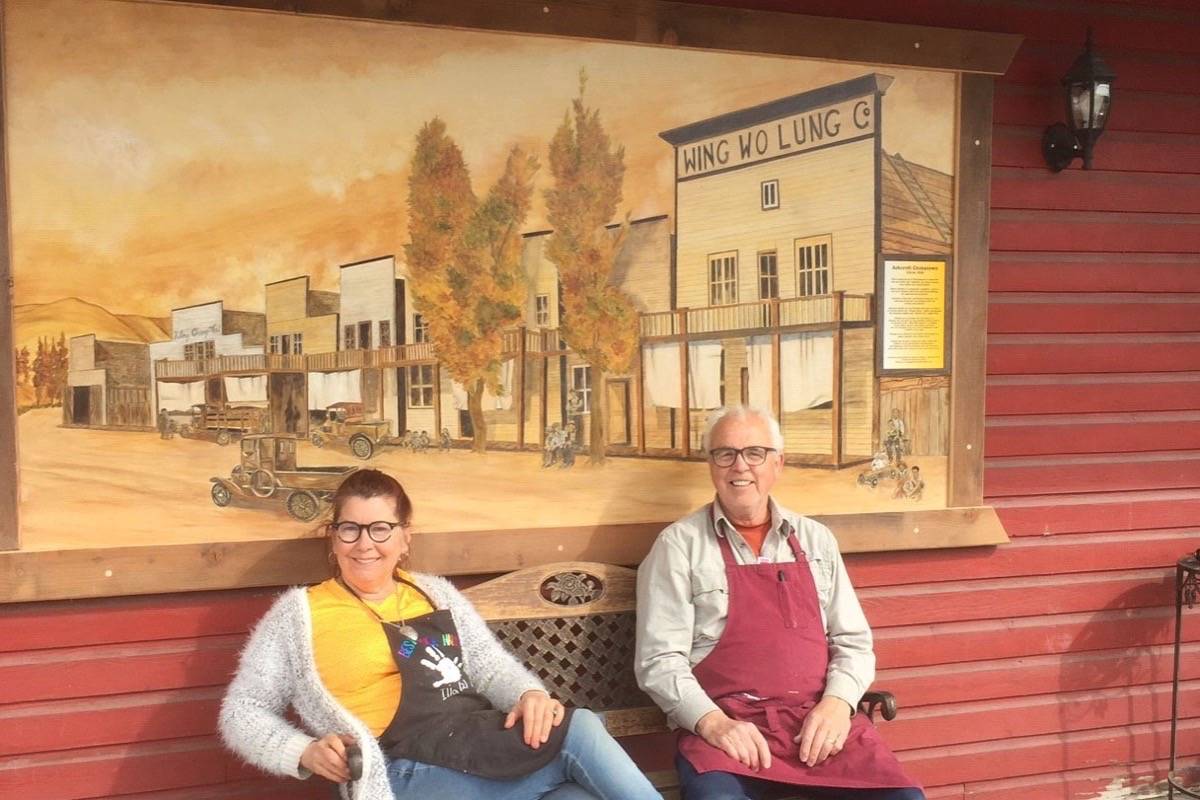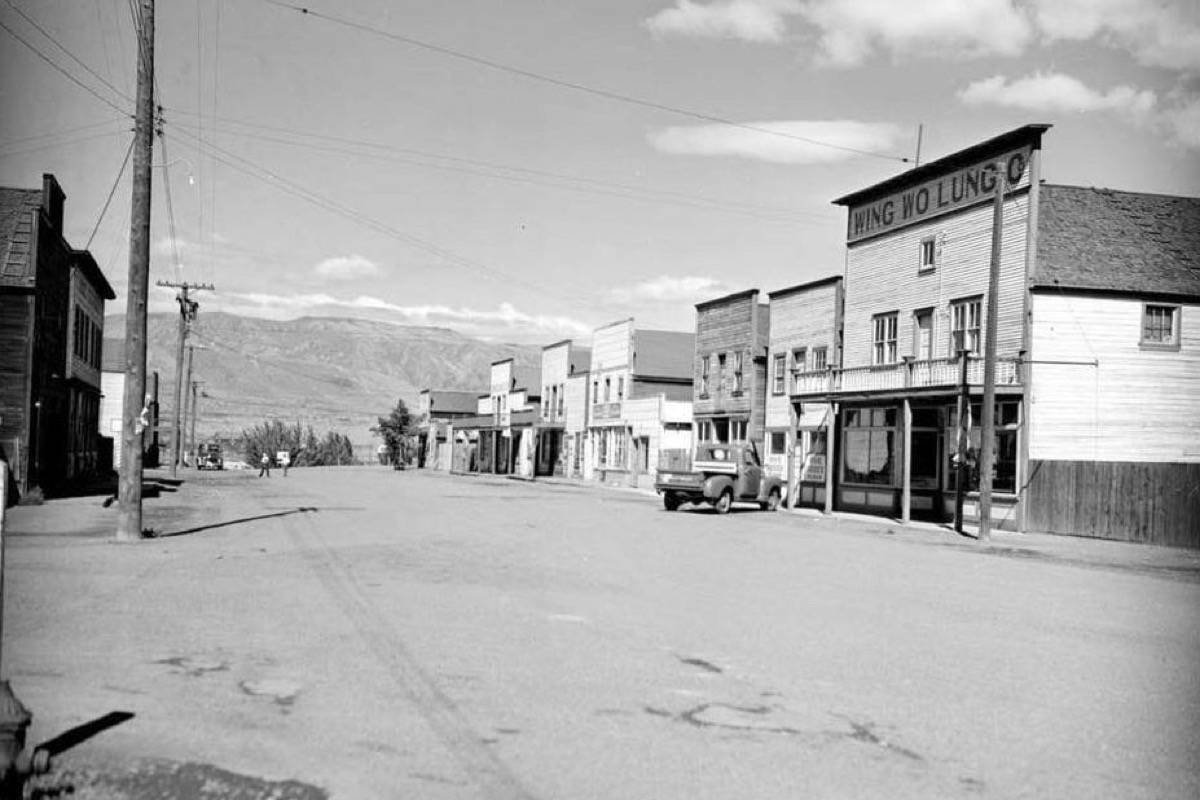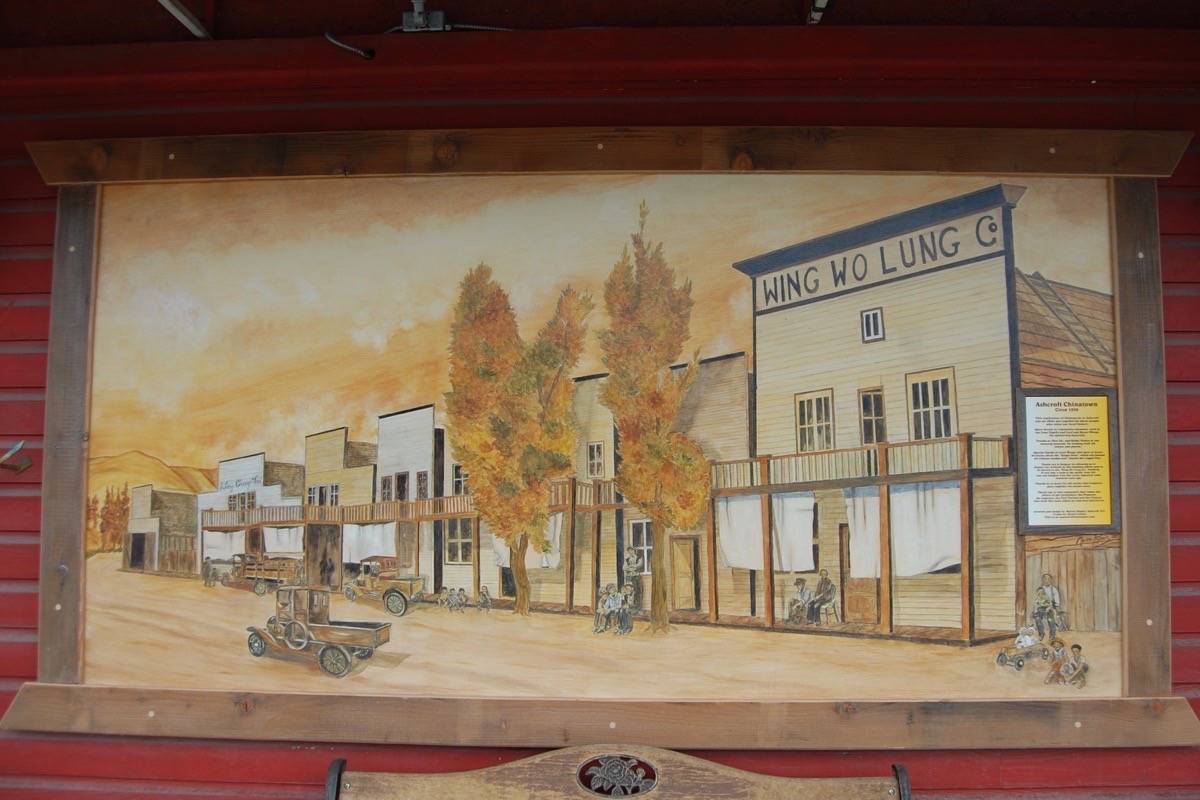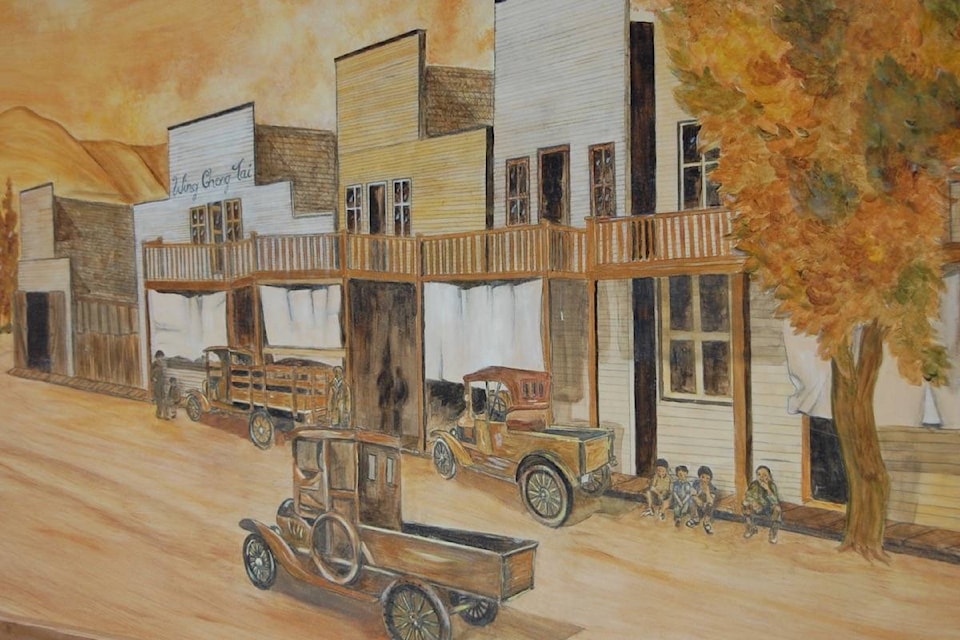A well-known photograph of Ashcroft, taken in 1952, shows a once thriving section of Railway Avenue that has all but vanished: Chinatown. Now that photograph has been brought to life by local artist Marina Papais, who went on a year-long journey researching the history of Ashcroft’s Chinatown and speaking with those who knew it before creating the work.
Those who know Papais primarily for the dozens of stunning glass mosaics that she has designed and created, and which are displayed all around town, might be surprised at her choice of medium for the new work: acrylic paint. And while most people probably assume that all of Chinatown has disappeared, the painting now hangs on the one building that survives from that part of Ashcroft’s history.
“I came across a photo of Chinatown at the Ashcroft Museum,” says Papais. She and her husband, architect Daniel Collett, are congregants at St. Alban’s Anglican Church in Ashcroft, which had been given some money by Loyd and Renee Wongs to create something about Chinatown.
“I spent many hours with Loyd Wongs before he died, and he told me so many stories. It was so important to him not to lose Chinatown. That legacy is lost if we don’t do something about it.”
She also got stories from Dave Lowe, and heard all about the ginger store that was owned by Charlie Aie, Loyd’s father. She also heard about Charlie’s friendship with the local First Nations people, and the support he gave to them and to the hobos who were frequent visitors to the town, riding the rails into Ashcroft.
“Charlie was really good to First Nations and to the hobos. He’d send out his young ones to collect apples, and got bacon grease from the restaurants, and made apple pies without sugar, because there wasn’t any. People came from far and wide to get Charlie Aie’s apple pies.
“He also filled his Coca-Cola up with vanilla, and it became Cokeanilla. He put lemon extract in 7-Up and it became Lemon-Up. The cops came, and Charlie got into big trouble, but he eventually got back to work.”
Papais says she heard many tales about Chinatown: of hidden staircases and secret societies, of gambling and opium dens, and of ghosts (two of which she incorporated into the painting). She scoured through numerous photographs to get the look of the buildings, and says that the people depicted in the painting are real townsfolke she spotted in old photos.
“People might be surprised it’s not a mosaic, but mosaics weren’t really my thing,” notes Papais of the painting. “I’m an architectural glass artist, but I did a lot of illustrative work and paintings. I really love painting and drawing. I never worked with mosaics and sold them; it was just a fun thing for me, and something anyone can do, putting pieces of glass down and making it look good. It’s great for public art.”
Over the last few years she has helped many people learn how to create mosaics. “I’ve brought the community in and people are participating. We’ve developed a community that’s expressing itself through art, and I can see it going forward.
“People can keep putting art out there so other people come to see our town. It’s great for economic development. Hopefully, with people not being able to get on planes and boats, they’ll come here and see Ashcroft. We can become a hotspot for tourists. I can see it really working for us.”
Once she started on the painting, Papais says that Collett helped her with the perspective. “Dan had to help with that, drawing all the lines so it made sense. He’s a draughtsman, so he understood. Without his help I couldn’t have done it.”
She had no idea where the painting would go, and at first thought she might change it out with one of her mosaics on the north wall of the Rolgear building, which is owned by Rob Suter and his wife Angela Bandelli and houses their business. Suter is the inventor and Bandelli is an artist, who runs an ever-changing display of artwork in the Sidewalk Gallery in the windows of the building on Railway Avenue.
“I see Angela every day,” says Papais. “Her horses live with us. She and I are massively simpatico. We’re both European, both artists.”
The Rolgear building was a natural place to hang the painting, since the northern, two-storey part of the building was originally the Wing Wo Lung store, although the façade has changed over the decades. Papais had already created a piece celebrating the Wing Wo Lung connection, which hangs on the front of the building.
“It’s a circle of glass, and behind it is an old mah jong table from the Wing Wo Lung building,” says Papais, who explains that it was found on the second storey of the building when Suter and Bandelli bought it and began renovating the second floor to turn it into living accommodations.
“It had been left behind up there. It’s an actual antique,” says Papais. “It’s from the days when there was gambling up there.”
The upstairs of the building — which was reached from inside by a tiny hidden staircase — was very interesting, she adds. It used to house poor Chinese workers, and she says that the walls were paper thin. “And there was paper literally glued to one side of the walls to stop wind getting into the cubbyholes where the workers lived. Conditions were rough up there. There were little partitions, just cheap clapboard with no insulation. I can’t imagine what it was like in the middle of winter.”
It was Bandelli who suggested that the painting go on the front of the building, where people can stand and look at it, then turn to the left and see where the buildings actually were.
“Marina and Dan were talking about the piece,” says Bandelli. “They’re friends of ours, and we were having an exchange about where it could go, what would be the best location.
“I had a blackboard there, and asked ‘How would it look here, right on the front?’ I think it’s the perfect spot for it. I wanted a place where people would walk by, and it’s near the bus stop where people wait.
“It’s the only part of Chinatown that still exists, where the painting is. You can look at the painting and then see where everything was, which makes it even more interesting. It’s right where it needs to be.”
Papais says it was a conscious decision to do the painting in sepia tones, to reflect old photographs. “It was the right way to go. It reflects something old, something nostalgic, and I love it.”
Once she started the painting it took three months to complete it, although the entire process of collecting stories and doing research took a year. “It takes a long time for ideas to come together. But it’s important that we keep up with the history of Ashcroft, and it’s exciting for travellers coming to town. We’re iconic for people coming to the Interior, a centre, the confluence of two railway lines.
“There are so many stories about how much the Chinese were part of our town. It was a magical experience for me to be part of gathering all the information for the painting.”
editorial@accjournal.ca
Like us on Facebook and follow us on Twitter



